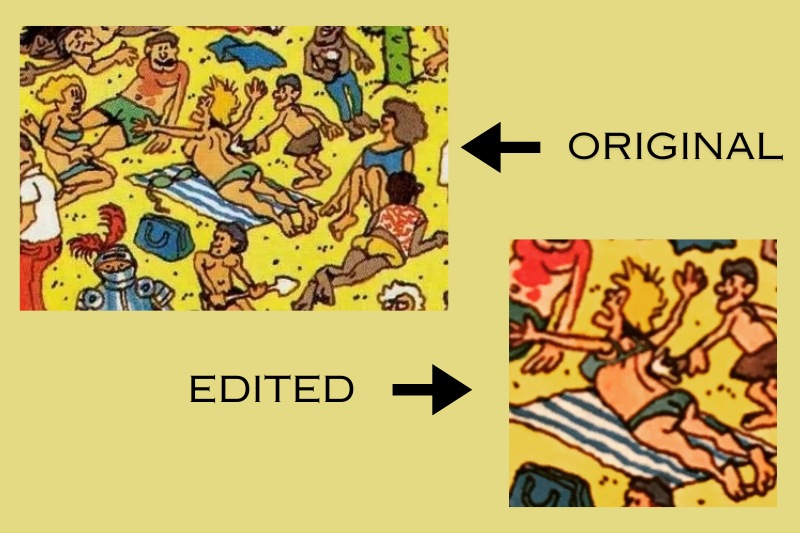The Where’s Waldo? series by Martin Handford, known internationally as Where’s Wally? is a beloved staple of children’s literature. It has vibrant illustrations with hidden characters and playful details. However, amidst its seemingly innocent world, the Where’s Waldo series briefly faced the challenge of being banned.

The Curious Case Why was Where’s Waldo Banned? Unraveling the Mystery
The reason for this attempted ban is, to put it mildly, surprising. It wasn’t violence or disturbing content. But a single image in the original 1987 edition of Where’s Waldo sparked controversy and it was banned.
The image depicted a crowded beach scene with a woman sunbathing. The crux of the issue? A sliver of her side breast was visible due to the way she was positioned.
This seemingly minor detail triggered outrage in some quarters. Critics argued that the scene was inappropriate for children. They accused of “topless sunbathers” and “inappropriate hidden imagery” flying.
These claims extended beyond the beach scene, alleging the presence of “seditious” messages. These include characters displaying a Hail Satan hand gesture.
The accusations of hidden messages seem far-fetched upon examination of the illustrations. The concern about the sunbather highlights the intense scrutiny children’s books can face. Parents and educators act as gatekeepers to align content with their values. They also ensure beliefs about what is appropriate for young minds.
Another primary reason why Where’s Waldo has been banned in certain regions is due to cultural sensitivities. The book’s illustrations often depict diverse scenes from around the world. It showcases various cultures, traditions, and landmarks. This can be educational and enriching for many readers. But it can also inadvertently perpetuate stereotypes or misrepresentations.
Authorities or community members find some illustrations offensive or inappropriate. For example, depictions of indigenous peoples, ethnic minorities, or religious symbols. Additionally, scenes depicting violence or suggestive imagery may raise concerns. So, parents and educators prompted calls for censorship.
However, the specific objections to the Where’s Waldo? scene raise interesting questions. The amount of skin exposed is minimal, compared to the imagery available online or on television. This begs the question: Was the real issue about nudity, or something else entirely?
Some argue that the controversy stemmed from discomfort with female sexuality. The act of sunbathing was traditionally associated with leisure and relaxation. But, it was perhaps deemed too suggestive when paired with a partially exposed breast. This discomfort reflects a broader societal struggle with female bodies and their representation.
Another possibility lies in the perception of decency. The beach scene might have been seen as too unruly or lacking decorum for some. This points to a desire for a sanitized, idealized version of reality within children’s books. This might not fully reflect the messy complexities of the world.
Ultimately, the attempted ban on Where’s Waldo? failed to gain significant traction. Public outcry and the absurdity of the accusations likely played a role. However, the episode serves as a reminder of the ongoing debates surrounding children’s media. Also, it covers the ever-evolving boundaries of what is considered appropriate.
Interestingly, the controversy also highlights the power dynamics at play. The objections came from adults, imposing their interpretations on children’s books. The children themselves, the intended audience, were largely absent from the conversation.
In the aftermath of the controversy, subsequent editions of Where’s Waldo? have the sunbather discreetly covered with a bathing suit top. This change reflects the publisher’s desire to avoid future controversy and focus on a wider audience over artistic integrity.
The Where’s Waldo? ban attempt, though ultimately unsuccessful, offers valuable lessons. It highlights the importance of critical thinking when evaluating children’s media. Are we truly protecting children, or are we projecting our own anxieties? Children are often far more capable of navigating complex narratives and imagery than we give them credit for.
Furthermore, the episode reminds us of the power of children’s literature. These seemingly simple books can spark important conversations about societal norms and gender representation. Perhaps the true “search” in Where’s Waldo? isn’t just for a character in a striped shirt, but for a deeper understanding of ourselves and the world around us.

Recommended: Why was Where the Sidewalk Ends Banned: Uncover the Controversies!
Why Did They Change Where’s Waldo to Where’s Wally?
There seems to be a slight misunderstanding! Actually, Where’s Waldo? never changed to any other name. It’s either Where’s Waldo? (North America and some other countries) or Where’s Wally? (UK and other countries).
The character’s name itself was changed during the book’s introduction to different markets. The original creator, Martin Handford, named him “Wally” – a common British name. However, publishers in North America felt “Waldo” would resonate better with their audience. So, the character’s name was localized for different regions.
What is the Girl Version of Where’s Waldo?
There isn’t an official girl version of Where’s Waldo?. However, there are a few options depending on what you’re looking for:
- Where’s Wanda? by Penelope Lawson
- Ophelia and the Marvelous Moths by Joan Lennon
What Happened to the Where’s Waldo Books?
The Where’s Waldo books (known as Where’s Wally in some regions) are still very much alive and well! Here’s a breakdown of their current status:
- Popularity: The series remains a beloved staple in children’s literature. Millions of copies have been sold worldwide, and new editions continue to be published.
- Controversy: The brief attempt to ban the books in the early 1990s due to a single image in one edition is a footnote in their history. Subsequent editions addressed the issue, but the series itself continues to thrive.
- Expansion: The franchise has expanded beyond the original search-and-find format. There are now various spin-offs like activity books, sticker books, and even video games, all featuring Waldo and his friends.
- Accessibility: The core concept of the books of finding hidden characters in detailed illustrations remains the same. However, some special editions of the original five books are no longer in print. The focus seems to be on newer titles and formats that cater to different age groups and interests.
Overall, the Where’s Waldo books haven’t disappeared. They’ve adapted and evolved. They continue to engage young readers with their signature blend of challenge, humor, and captivating illustrations.
When did Waldo become Wally?
Waldo never actually became Wally! There wasn’t a single point where the character’s name switched. Here’s the breakdown:
- Original Name: The character’s original name, as envisioned by the creator Martin Handford, is Wally.
- Market Localization: When the book series was published in different regions, publishers decided to localize the name for better audience connection.
- North America vs. UK: In North America, the publishers felt “Waldo” would resonate better, thus the name change. In the UK and other territories, the book retained the original Where’s Wally? title.
So, Waldo and Wally are essentially the same characters with a name change depending on the region where the book is published.
Recommended: Banned Books of Ernest Hemingway: More Than Just a Fistfight



